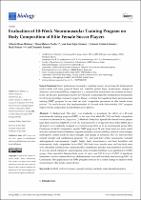Por favor, use este identificador para citar o enlazar este ítem:
https://repositorio.usj.es/handle/123456789/821
Registro completo de metadatos
| Campo DC | Valor | Lengua/Idioma |
|---|---|---|
| dc.contributor.author | Roso-Moliner, Alberto | - |
| dc.contributor.author | Mainer Pardos, Elena | - |
| dc.contributor.author | Arjol-Serrano, José Luis | - |
| dc.contributor.author | Carton-Llorente, Antonio | - |
| dc.contributor.author | Nobari, Hadi | - |
| dc.contributor.author | Lozano, Demetrio | - |
| dc.date.accessioned | 2022-07-20T11:11:09Z | - |
| dc.date.available | 2022-07-20T11:11:09Z | - |
| dc.date.issued | 2022-07-17 | - |
| dc.identifier.citation | Roso‐Moliner, A.; Mainer‐Pardos, E.; Arjol‐Serrano, J.L.; Cartón‐Llorente, A.; Nobari, H.; Lozano, D. Evaluation of 10‐Week Neuromuscular Training Program on Body Composition of Elite Female Soccer Players. Biology 2022, 11, 1062. https://doi.org/10.3390/ biology11071062 | es_ES |
| dc.identifier.issn | 2079-7737 | es_ES |
| dc.identifier.uri | https://repositorio.usj.es/handle/123456789/821 | - |
| dc.description.abstract | Background: This study was conducted to investigate the effects of a 10‐week neuromuscular training program (NMT) on the sum of six skinfolds (Σ6S) and body composition variables in elite female soccer players. (2) Methods: Forty‐four Spanish elite female soccer players (age: 24.0 ± 4.2 years; height: 164.3 ± 5.5 cm; body mass: 60.4 ± 5.5 kg; body mass index (BMI): 22.4 ± 2.2 kg/m2) were randomly assigned to a control group (CG) or to an experimental group (EG). Participants in the EG completed a specific NMT program of 24 min, three times per week, which included exercises from six different categories (mobility, dynamic stability, anterior chain strength, lumbopelvic control, posterior chain strength, and change of direction). The CG followed their normal strength and conditioning program. Pre‐ and post‐intervention assessments included anthropometric measurements (weight, height, limb circumferences, and bone breadths), and subsequently, body composition factors BMI, Σ6S, body mass, muscle mass, and lean body mass were calculated. Nutrition was standardized by a nutritionist and also load monitored. (3) Results: A two‐way mixed analysis of variance (group x time) revealed that there was a significant (p ≤ 0.001) group x time interaction between body mass, fat mass, and Σ6S in favor of NMT. A significant interaction was also observed for body skeletal muscle mass and lean body mass favoring NMT. (4) Conclusions: The application of an NMT program seems to be a useful strategy to improve body composition in elite female soccer players. | es_ES |
| dc.format.extent | 15 p. | es_ES |
| dc.format.mimetype | application/pdf | es_ES |
| dc.language.iso | eng | es_ES |
| dc.publisher | MDPI | es_ES |
| dc.relation | This work was supported by Universidad San Jorge (Internal Research Project 2021–2022) and Departamento de Ciencia, Universidad y Sociedad del Conocimiento from the Gobierno de Aragon (Spain) (Research Group ValorA No. S08_20R) | es_ES |
| dc.rights | Attribution-NonCommercial-NoDerivatives 4.0 Internacional | * |
| dc.rights.uri | http://creativecommons.org/licenses/by-nc-nd/4.0/ | * |
| dc.subject | Football | es_ES |
| dc.subject | Body fat | es_ES |
| dc.subject | Women | es_ES |
| dc.subject | Strength training | es_ES |
| dc.subject | Lean body mass | es_ES |
| dc.subject | Kinanthropometry | es_ES |
| dc.title | Evaluation of 10‐Week Neuromuscular Training Program on Body Composition of Elite Female Soccer Players | es_ES |
| dc.type | info:eu-repo/semantics/article | es_ES |
| dc.identifier.doi | https://doi.org/10.3390/biology11071062 | es_ES |
| dc.rights.accessrights | info:eu-repo/semantics/openAccess | es_ES |
| Aparece en las colecciones: | Artículos de revistas | |
Ficheros en este ítem:
| Fichero | Descripción | Tamaño | Formato | |
|---|---|---|---|---|
| Evaluation of 10‐Week Neuromuscular Training Program.pdf | 995,53 kB | Adobe PDF |  Visualizar/Abrir |
Este ítem está sujeto a una licencia Creative Commons Licencia Creative Commons

